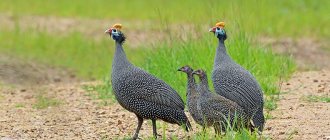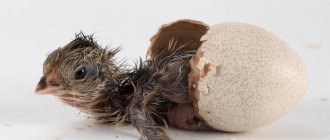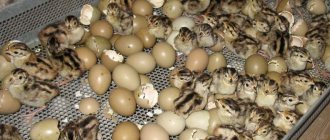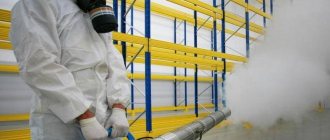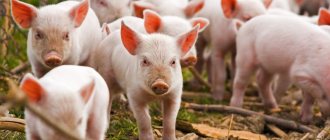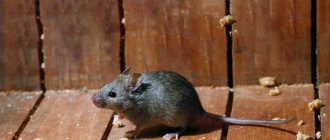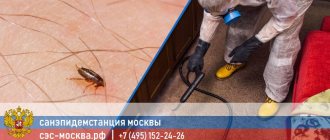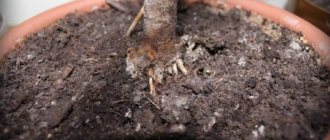Due to the fact that guinea fowls are poor brood hens and their maternal instinct leaves much to be desired, farmers give greater preference to hatching chicks using an incubator. But this process requires a responsible approach, because if the temperature or humidity level is not maintained correctly, all efforts may be in vain.
Primary requirements
There are a number of specific requirements that must be observed during incubation. Initially, you need to be able to choose the right eggs, because not all of them are suitable for future breeding of chicks. There are also some requirements for the incubator.
Egg quality
Normally, a guinea fowl lays eggs for six months, but if you provide it with good lighting and maintain a constant temperature, this period can increase to 8-9 months. It will be possible to hatch offspring from 70-80% of eggs, divided into several categories: small, medium, large.
The main requirement is to choose eggs of the same size. That is, you cannot put medium and large, or small and medium eggs into the incubator at the same time. Other requirements are practically no different from those for breeding other birds:
- Choose whole and pre-disinfected eggs. Typically, farmers use a quartz lamp for irradiation. At home, it is permissible to use a weak solution of potassium permanganate or an alcohol solution of iodine. After this procedure, the eggs are rinsed with warm water and wiped dry. Eggs are collected in the morning until 10-11 o'clock.
- Eggs must meet the standard: pear-shaped, sharp end, free from unevenness and defects.
- Immediately at the moment of laying the eggs in the incubator, it is necessary to first hold them at room temperature (several hours) - this promotes gradual heating.
- Eggs are taken only from females that are at least 1 year old. For this reason, collection begins no earlier than May.
- It is advisable to take those eggs that the guinea fowl will lay no earlier than three weeks from the start of laying. The reason for this is that the first eggs are often unfertilized.
- Eggs are selected according to typical parameters: very small ones and overly large ones are laid aside. You can find out about the presence of an embryo in an egg using an ovoscope to check.
Requirements for the incubator
Within 28 days, it is necessary to provide the eggs with temperature and humidity conditions. If you deviate even slightly from the schedule, the embryo may freeze. The network device must be equipped with a battery, which will be switched to in case of power outages.
The humidity in the chamber must be maintained by the evaporator and automation; the readings of the wet and dry thermometer must be under control. The incubator must also provide protection against overheating. Even if the temperature rises even for one minute, the entire brood may die. A prerequisite is regular air exchange in the thermostat; there are holes in it, through which air circulates.
When incubating guinea fowl, each egg releases 3.5 liters of carbon dioxide and absorbs 4 liters of oxygen. If the incubator provides for automatic turning of trays with eggs, the poultry farmer must ensure that they are installed with the blunt end up. When turning eggs by hand, lay the eggs on their side.
What it is?
The term is translated from Latin as “to hatch”, “to endure”. This is a natural development process from the moment the egg is laid until the individual emerges. Incubation takes place at given environmental parameters: a certain temperature, humidity, lighting . To breed guinea fowl at home or on an industrial scale, an incubation cabinet is required. It must have a thermometer, heating and lighting system.
Which eggs are unsuitable?
Before sending eggs to the incubator, the farmer must carefully inspect and check them. Not all eggs are suitable for incubation. The following eggs are not considered a “correct” product:
- weight less than 35 g;
- there is contamination;
- there are defects, growths, and damage on the shell;
- two yolks inside;
- Blood impurities are visible inside when examined.
Suitable eggs are stored in a dark, cool place at the correct temperature and humidity level. Rejected eggs are not placed in the incubator.
How to prepare incubation material for laying?
The incubator must be installed in a room where the constant temperature is at least +20 degrees. A few hours before laying, leave the eggs in the room where the equipment is located. Before sending the eggs into the incubator, it is heated to a temperature of +38 degrees.
Many poultry farmers note that it is better to choose incubators that provide an automatic egg turning function. If there is no such function, it’s okay, you’ll just have to put a little effort into turning the eggs manually. For convenience, it is recommended to label eggs. It also wouldn’t hurt to draw a table with notes about turning the eggs. After laying the eggs, they are not touched for 12 hours. That is, the eggs are turned for the first time half a day after the eggs are sent to the incubator.
Next, the eggs are turned 6 times a day to prevent the embryo from sticking to the shell. This mode will allow all products to warm up evenly, which will significantly increase hatchability and increase the percentage of healthy chicks.
It is allowed to lay eggs at any time of the day, but experienced poultry farmers recommend doing it in the evening. Before laying, be sure to sort the eggs by weight. Each group, depending on the size of the eggs, is placed in separate trays.
Conditions of detention
Any poultry farmer who knows at least a little about the habits of guinea fowl will tell you with confidence that these birds are very nimble and love freedom. Therefore, if you want to provide your birds with complete care, you need them to have the opportunity to walk freely around the yard or in a larger enclosure. Of course, it’s not so scary if you keep your birds indoors. But this can negatively affect their fertility.
It’s great if not far from your house there is a meadow with fragrant, lush herbs, or the edge of a forest. There the birds will be able to get their own food, and you will save significantly on feed. And don’t worry that the birds will get away from you somewhere. If you stick to the feeding schedule, your guinea fowl will return home on time. In addition, the developed feeding regime has other advantages, because under no circumstances should birds be left to their own devices, otherwise they will go wild.
Guinea fowl have a timid, active disposition. In addition, they are very loud. This is probably the only disadvantage of keeping guinea fowl. But any animal can be tamed
And if you pay attention to the birds, they will get used to you, to your voice, and will become calm pet birds. But if someone strange appears in the yard, be prepared for the guinea fowl to start screaming loudly
By the way, it would be unfair to these royal birds if we do not note that guinea fowl are the most cultivated birds of all domestic birds. Even if you release them into the garden, you don’t need to worry about the harvest. Birds will not rake the beds and eat vegetables, but they can help you in the fight against harmful insects and weeds. After all, larvae, worms, and beetles are the favorite delicacy of guinea fowl.
A specially equipped room for keeping guinea fowl is not required. And this is another advantage of breeding these very hardy and unpretentious birds. They will feel great in an ordinary chicken coop, but, of course, a little more space needs to be allocated per individual - for every two individuals there should be 1 square meter. m. Birds can also withstand severe frosts, so it is not necessary to particularly insulate the room.
But you should still take care and make perches so that the birds do not sit on the cold floor. The temperature of the room in which day-old chicks are kept should be about 36 degrees. But by the end of the third week it can be gradually reduced to 25. The temperature requirements for the room in which adult guinea fowl will live are no different from the requirements for a chicken coop. Of course, no one argues that if you have the opportunity to keep guinea fowl in a heated room, then this will only be a plus. Indeed, in this case, fertility will not decrease even in winter.
It is necessary that the floor be covered with dry bedding made from sawdust, straw, or wood shavings, which should be changed every month. In winter, guinea fowl will not refuse to walk, but make sure that they walk on cleared ground and not on snow. The walking area can be covered with straw.
It is important that the room in which the birds are kept is well ventilated. But provided there are no drafts. Otherwise, guinea fowl may get sick
Otherwise, the guinea fowl may get sick.
In winter, you should take care of additional lighting. Turn on the lights at 7 a.m. and turn them off around 10 p.m. Birds lay eggs only in the light, so lengthening the daylight hours is necessary to stimulate egg laying.
You can feed guinea fowl the same as chickens. However, it should be borne in mind that half of the total daily diet of royal birds should be greens, as well as various vegetables, which are probably plentiful in your homestead.
In addition, in winter you need to think about additional feeding of birds with wet mash from sour milk, fish oil, and meat waste. In the evening, give the birds grain and feed, because they are very nutritious and take a long time to digest, so the guinea fowl will not feel hungry throughout the night.
If you decide to equip an enclosure for walking, then keep in mind that guinea fowl fly well, so the height of the mesh for the fence should be at least two meters. To make the birds feel comfortable, plant several bushes in the aviary, and also put up a small canopy. Like chickens, guinea fowl are big fans of digging in the ground, so give them this opportunity by pouring a pile of sand in the walking area. Birds will not refuse ash baths either.
If you follow these simple rules, you will be delighted with guinea fowl eggs all year round.
Incubation modes
In order for incubation to be successful, it is necessary to establish the correct temperature and humidity conditions from the very first hours. For the first few weeks, the temperature in the incubator should be +37.8 degrees, humidity – 60%. If the incubator does not provide automatic humidity control, it is allowed to install a container of water in it.
On day 6 you need to start cooling the eggs. To do this, lift the incubator lid once a day and leave it open for 5-6 minutes. Two weeks after laying, the temperature is reduced by two degrees. The humidity level should be up to 50%. Continue to turn the eggs at least 6 times a day. Open the lid for 10 minutes.
Three days before the end date, they stop turning the eggs, but the temperature and humidity should be the same as at the beginning of laying. They no longer open the incubator lid.
The table shows in detail at what time, what the temperature and humidity should be:
| Term | Temperature | Humidity level | Number of revolutions | Ventilation |
| from 1 to 2 days | 38 degrees | 65% | 6 | — |
| from 3 to 14 days | 37.5 degrees | 60% | 4 | 5-6 minutes |
| from 15 to 23 days | 37.5 degrees | 55% | 3 | 10 minutes |
| from 24 to 25 days | 38 degrees | 65% | — | — |
| from 26 to 28 days | 37 degrees | 68% | — | 7 minutes |
Compliance with all conditions will ensure the health of the bird and the good development of the young. This process must be approached very responsibly.
Are you here
For incubation, eggs obtained from guinea fowl from 34 weeks of age are used. Eggs are collected every 3 hours and placed in a special container.
A preliminary assessment of eggs based on the sanitary condition of the shell is carried out in the poultry house, dividing them into clean and dirty. At the egg warehouse, eggs are assessed by appearance and by examination with an ovoscope. The air chamber should be at the blunt end of the egg or slightly offset to the side. Its diameter in a fresh cesarine egg does not exceed 1.2 cm. The yolk should occupy a central position or be slightly shifted towards the air chamber, inactive when the egg is rotated.
Eggs are stored with the air chamber upward in an egg warehouse equipped with ventilation and a refrigeration unit at a temperature of 8-12 ° C and a relative humidity of 75-80%. The shelf life of eggs from laying to placing them in the incubation cabinet is no more than 7 days. To evaluate eggs according to morphological and biochemical parameters, 10 eggs are taken selectively. from the party.
The mass of hatching eggs should be in the range of 38-52 g. The height of the air chamber is no more than 7.0 mm, elastic deformation is 16 microns, egg density is 1.125 g/cm3, shape index is 72-78%, protein index is 0.080, Howe units - 80. 1 g of yolk must contain at least 30 mcg of carotenoids, at least 10 mcg of vitamin A, and at least 4 mcg of vitamin B2. Egg fertilization is at least 75%, hatching of young animals is at least 60%.
Eggs that are irregular in shape (elongated, spherical, with interceptions), double-yolk, with a displaced or movable air chamber, or with shell defects (growths, cracks, notches, etc.) should be considered unsuitable for incubation.
Eggs selected for incubation are placed in trays and disinfected with formaldehyde vapor. For 1 m3 of disinfection chamber, 30 ml of formalin, 15 ml of water and 20 g of potassium permanganate are used. Treatment time is 30 minutes at an air temperature of 24-35 ° C and a relative humidity of at least 65%.
Guinea fowl eggs are incubated in commercial incubators of any type. The incubation regime is as follows: from days 1 to 13, temperature 37.8 °C, humidity 58-62%; from 14 to 24 days - 37.5 °C and 45 - 50%, respectively. On the 24th day of incubation, before transferring the eggs to the hatcher, biological control is carried out, and unfertilized eggs with a blood ring and frozen embryos are removed. Eggs with normally developing embryos are placed tightly in hatcher trays and transferred to a hatcher.
The incubation mode in the hatcher before hatching is as follows: temperature 37.0–37.2 °C, air humidity 58%. After the peck appears, the temperature is left at the same level, and the humidity is increased to 96%.
The duration of incubation of guinea fowl eggs is 27 days. During this period, guinea fowl eggs lose 12-14% in weight (of their original weight). Completely dried guinea fowl are selected from the hatcher and sorted
When sorting, pay attention to the condition of the umbilical ring, cloaca, legs and down, beak and eyes
Guinea fowl are accepted for rearing if their live weight is not less than 27 g, without defects in appearance, mobile, and responsive to sound. In healthy guinea fowl, the belly is soft, tucked in, the residual yolk is completely retracted, the cloaca is pink, clean, the fluff is soft, shiny, the legs and beak are strong, the eyes are clear and shiny, the head is wide, the beak is short and thick, the wings are tightly pressed to the body. When selecting guinea fowl for rearing, it is recommended to take into account the timing of their hatching. For breeding purposes, guinea fowl hatched after 27 days of incubation are used.
Checking embryo development and candling eggs
During the entire incubation period, it is necessary to check and monitor the development of guinea fowl embryos at least four times. It is important to get rid of an unsuitable egg in time if the embryo freezes - this will avoid the development of rotting, cracking of the shell and the release of the infected mass to the outside. The first time after laying the embryos is checked on the 8th day. It is during this period that the first period of embryonic development ends.
If no changes are detected during the first ovoscoping, then most likely the eggs have not been fertilized and they must be removed from the incubator.
During the first candling, it is necessary to evaluate the quality of the eggs, as well as the development of the circulatory system of the embryo. When examining the egg, blood vessels approaching the sharp end should be clearly visible; the embryo should not be visible. In this case, the egg is translucent with a pink tint.
If the condition of the vessels is in perfect order, then they are not visible very well, slightly penetrating beyond the middle of the shell. This may indicate that not all chances for normalization of the embryo are lost.
If the embryo is close to the shell, this may mean that it is not developing well. In this case, the egg is predominantly pale in color, and the vessels are practically invisible and absent in the acute part.
You can easily make an ovoscope yourself using a small cardboard box and a 60 W light bulb - it is placed at the bottom of the box. An oval-shaped hole is cut out on the lid of the box, slightly smaller in size than an average egg.
The second ovoscopy is carried out on the 15th day after completion of the second stage of development. Eggs with visible bloody spots on an orange background are removed. The third ovoscopy is carried out after 24 days. At this time, it is clearly visible where the embryo has frozen and where it is developing well. All eggs with frozen embryos must be removed from the incubator. After the first pecks appear, it is necessary to spray the eggs with water to increase humidity.
Ovoscopy
The inspection is carried out using a special device that illuminates the contents of the egg; the presence of cracks may indicate that the individual is unsuitable for further incubation.
The inspection technique is simple - the egg is brought to the ovoscope and examined in a longitudinal position. If the procedure is carried out correctly, you can notice all the shortcomings.
During the ovoscoping process the following defects may occur:
- Marble shell structure.
- Light stripes from damage.
- Large air chamber.
- Presence of blood clots and dark spots.
- Presence of foreign objects.
- Contents are orange.
- Yolk fixed in one place.
Step-by-step instructions for the entire process
Incubation is a painstaking process that requires compliance with certain rules. The poultry farmer must know how many days the eggs lie in the incubator, and what to do during this period:
- Before sending the incubation material, it is necessary to keep it in a cool room for some time so that condensation does not form on the eggs after turning on the incubator. Otherwise, mold may develop on the eggs, causing them to spoil. Eggs are placed indoors at a temperature of no more than +12 degrees. There should be no drafts and no sunlight penetrating.
- Place eggs of the same size on one tray. They start with large specimens. The bookmarking process should last no more than four hours.
- The air humidity in the incubator should be about 65%, the temperature should be 37.8-38 degrees. Disinfection with formaldehyde vapor will ensure high-quality hatching of guinea fowl in the incubator.
- In the first days, the temperature should be maintained at 37.6 degrees, humidity at 60%.
- Incubation of guinea fowl eggs involves turning them three times during the day. This helps supply the core with the necessary amount of nutrients.
- After a week, you will need to check all the eggs for embryos using an ovoscope. This will allow you to select embryos that have stopped developing and bacterially infected eggs.
In the following video, poultry farmer Elena Krylova shares her personal experience of hatching guinea fowl chicks in an incubator:
Caring for ducklings
Once the ducklings are born, they will require a little extra care, just like any newborn.
Nutrition
In the first days, it is better to feed them from a pipette with a light pink solution of potassium permanganate, rather than water, even boiled. On the first day, only crumbled boiled eggs can be given as food. The next day you can slowly add soft cereal porridge. It is advisable to feed every 2-3 hours. This diet should be followed for 10 days until the ducklings get stronger.
Next, you can add chopped fresh herbs, boiled potatoes, duckweed, and, if desired, milk and cottage cheese of medium (low) fat content to the ducklings’ menu, gradually increasing the intervals between meals.
After 30 days, the diet changes to 2 meals a day - morning and afternoon. The diet should mainly consist of corn, mixed feed and wheat; if you wish, you can try other grains. Mineral and vitamin supplements are required. And also pour crushed eggshells, small pebbles and shells into a separate container. Birds need this for good digestion.
Temperature and light conditions
Maintain a stable warm temperature - approximately +20.23 degrees, monitor humidity, and do not turn off the lighting in the first days. This regime is necessary for the proper development of ducklings and the prevention of diseases; they are still too small and can easily catch a cold. A week after hatching, begin to gradually accustom the ducklings to the dark, reducing the amount of time their room is illuminated. They can be released into fresh air only after they have grown a little, and only for a short time. The duration of the walk should be increased as the chicks grow older.
Alas, due to the characteristics of the breed, Mulards are slaughtered in the third month of life, when they gain sufficient weight - approximately 3.5 kilograms.
To learn about the features of incubating mulard eggs, see the following video.
Ways to increase humidity levels
If a poultry farmer initially acquired an expensive, programmable incubator, he will not have any difficulties setting the desired humidity, temperature, and number of egg turns per day.
But if the incubator model is old, you will have to try a little. To increase humidity, it is recommended to spray the eggs. But this is only if there is an external fan. But for spraying you will have to open the incubator.
If the model is semi-automatic and has a built-in fan, it is dangerous to spray the eggs, because water can get into the electrical system. Then you just need to insulate the incubator, isolating it from the environment. But, one way or another, raising the humidity to 80% will not work.
Homemade incubators that do not have an automatic detector, humidity is calculated from the table, taking into account the temperature difference between the dry and wet thermometer. A wet bulb thermometer has a cloth wick wrapped around the bottom tip. The second end of the wick is lowered into a container of water.
If the incubator is quite large, you can increase the humidity in it by installing a container of hot water. But at the same time, the temperature will rise, which can negatively affect the chicks.
How to choose healthy individuals when purchasing?
For proper breeding of guinea fowl, an important point is the selection of healthy birds, with which there will be no difficulties in the future. It is recommended to purchase birds from a specialized poultry farm - this guarantees the origin, health and productive qualities of the animal. At the time of purchase, you should ask the seller for a veterinary certificate; it must indicate all the necessary information about the bird.
They purchase more often day-old guinea fowl. It is during this period that the chicks will suffer least from transportation. If you buy older guinea fowl, you will have to transport the birds in a special container. Sometimes, long-term transportation requires providing the birds with food and water. It is not recommended to purchase adult specimens.
In order not to make a mistake in choosing and buy healthy guinea fowl, the poultry farmer will need to pay attention to some features:
Externally, the bird should look large, not limp, have no defects on the body, and have a characteristic color pattern. A healthy animal has shiny, mobile, bulging eyes, and the pupils are not reduced in size. You should not buy birds that show signs of rickets, for example, a curved breastbone or wings. Exhausted individuals with poor coordination of movement and a swollen belly are not suitable for breeding.
When purchasing an adult 5 month old, pay attention to its weight. During this period, females should weigh at least 1.3 kg, males - about 1.4 kg
When do chicks hatch after laying eggs?
On the 27th day, sometimes earlier, pecks may appear on the eggs. For the guinea fowl to finally form and hatch, it will take about a day. If there were no violations in the incubation regime, the conclusion may be friendly. But everything depends on the development of the chicks, that is, some can almost immediately get up and try to walk, while others can lie down and recover.
Those chicks that immediately try to run after hatching should be caught and moved to the brooder. Guinea chickens are agile babies who can quickly get caught in some hole and get stuck there. Calm chicks need to be left in the incubator for some time so that they gain strength.
Day old chicks and their inspection
The hatching of the chicks itself takes place in several stages. When a chick pecks at the shell, this can often be seen, followed by a squeaking sound. The second stage involves the complete hatching of the chick within a few hours. Based on the mass of the babies, it will be possible to accurately answer how much the egg weighed approximately:
| Chick weight | Egg weight |
| 38-40 g | 23-27 g |
| 41-43 g | 27-29 g |
| 44-46 g | 30-32 g |
| 47-55 g | 33-35 g |
It is considered normal if the chick loses 14-15% in weight over the entire incubation period.
To objectively evaluate the chick after hatching, you need to wait 12-24 hours. Usually a healthy baby is mobile and active, and looks good in appearance. Such chicks are distinguished by a clear and lively look, shiny, slightly bulging eyes, a fully retracted umbilical cord, and bright orange paws. Healthy guinea fowl have a soft belly to the touch, and the body is covered with soft fluff that glistens in the light.
It is allowed to transfer chicks to the brooder only after they are completely dry. It is important to immediately select the strongest guinea fowl and remove lethargic, sickly babies. It is believed that the healthiest babies are born within 17-20 hours after pipping.
Selecting chicks to create a flock
The larger the eggs were when they were placed in the incubator, the stronger the offspring will be. For rearing, guinea fowl are selected from the brooder after birth, 8-12 hours later. At this time, a standard chick can already stand firmly on its feet and respond to tapping on the box. The strongest chicks are left to form a parent flock and continue the family line.
If the number of healthy chicks is 60-65% of all eggs laid in the incubator, this is a normal indicator. The optimal value can be obtained by laying the eggs of those birds whose age ranges between two years.
How to incubate guinea fowl in home and farm breeding
Beautiful birds with dietary meat, guinea fowl, resemble both chickens and turkeys. The female's parental instinct is poorly developed; incubating guinea fowl or placing it under a chicken allows offspring to be produced. The lifestyle of guinea fowl differs little from that of a chicken. They need the same diet, a chicken coop with roosts. Guinea fowl cannot tolerate dampness and cramped conditions. An adult bird weighs about 2 kg.
Is it possible to speed up the process of breeding guinea fowl?
Beginning poultry farmers are interested not only in the moment of incubation of guinea fowl eggs, but also in the possibility of accelerating the hatching of chicks. In general, incubation of guinea fowl eggs lasts 27-28 days. If everything was done correctly, all babies should be born on the 28th day after laying the eggs in the incubator. High humidity can delay the formation of the embryo.
As for whether it is possible to speed up the process of breeding guinea fowl, the answer is clear - no. The first chicks will begin to hatch no earlier than on the 27th day. To make it easier for children to peck at the shell, it is moistened a little with water using a spray bottle - this will not only make it thinner, but also softer.
Common mistakes made by novice poultry farmers
Beginners who decide to start breeding chickens in an incubator often encounter difficulties due to their inexperience. The most common mistakes in this process are:
- Incorrect turning of eggs. Often, the poultry farmer takes long intervals between turning eggs, which is why the embryo dries to the shell.
- Incorrect temperature detection. The reason for this may be the location of the thermometer in the wrong place. The thermometer should be level with the eggs.
- Lack of moisture. Guinea fowl are birds that prefer humidity. Be sure to carefully monitor the humidity level. If necessary, it is necessary to spray the incubation material.
- Overheating of eggs. This can lead to the fact that the chicks may begin to peck at the eggs earlier than expected. So babies will be born underdeveloped, and therefore will not live long.
- Underheating of eggs. If the incubation material is not warmed up properly, the brood will not only be born late, but will also have some abnormalities. There is also a possibility of a decrease in the percentage of excretion.
The process of selecting quality eggs for further placement in the incubator is a responsible matter that requires the right approach. Incubation of guinea fowl eggs will allow you to hatch healthy chicks if you properly monitor the development of the embryos and treat the guinea fowl with care in the future.
0
0
Copy link
If there are problems?
There are a number of factors that in one way or another affect the hatchability of guinea fowl and it is because of them that certain problems can arise. Below are tips that can help the breeder increase the percentage of chicks hatched.
The best results in terms of fertility are given by females aged 2-4 years
- Incubation of guinea fowls should take place without violating the regime, so it is worth buying a good device with an additional battery.
- The receipt of a large number of unfertilized eggs is most often associated with poor living conditions of the maternal flock, as well as a lack of vitamins and minerals in the female’s body.
- The best results in terms of fertility are given by females aged 2-4 years. Males are most productive up to 2 years of age.
- Mating of young males with 2-year-old guinea fowls increases fertilization.
